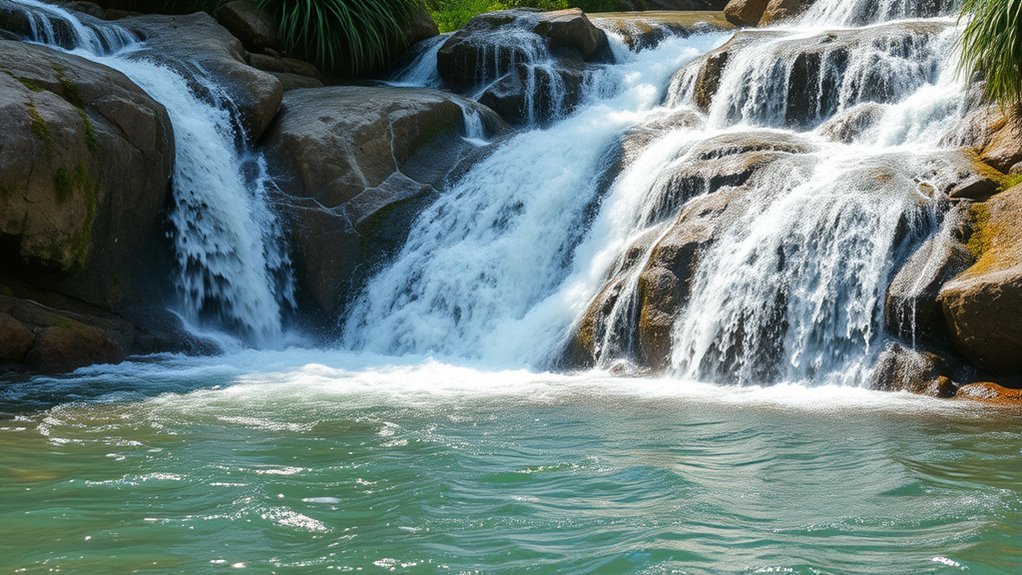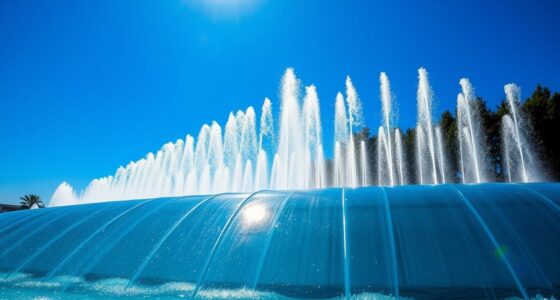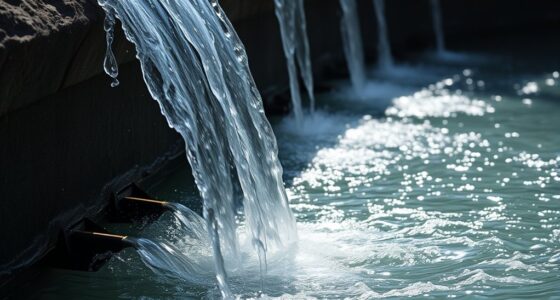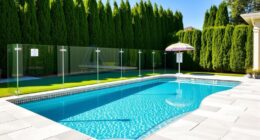Waterfalls, bubblers, and sheer descents boost water circulation by creating turbulence and surface agitation. This movement helps aerate the water, increasing oxygen levels essential for aquatic life and preventing stagnation. It also distributes nutrients, reduces odors, and discourages algae growth. By improving flow, these features support healthier ecosystems and stabilize environments. To discover how these dynamic water features can transform ecosystems further, continue exploring the ways water movement impacts ecosystems and microclimates.
Key Takeaways
- Waterfalls, bubblers, and sheer descents create surface agitation that increases oxygen transfer in water.
- These features generate turbulence, promoting uniform circulation and preventing stagnation in aquatic environments.
- They help disperse nutrients and pollutants evenly, maintaining water quality and ecosystem health.
- The movement from these features cools surrounding air, influencing local microclimates positively.
- Automated controls optimize flow and circulation, enhancing water feature efficiency and environmental benefits.
The Role of Water Movement in Ecosystem Health

Water movement is essential for maintaining the health of ecosystems because it directly influences the distribution of nutrients, oxygen, and organisms. When water flows, it disperses crucial nutrients throughout the environment, ensuring plants and microorganisms get what they need to thrive. Moving water also helps oxygenate habitats like lakes and rivers, supporting fish and other aquatic life. Without circulation, stagnant water can become depleted of oxygen, promoting harmful bacteria and algae growth. This imbalance threatens the entire ecosystem’s stability. As you observe water features, you see how movement keeps the environment dynamic and balanced. It prevents buildup of toxins and encourages the natural cycling of materials. Regular water circulation also supports vertical storage solutions, which help maintain a clean and healthy aquatic environment. In short, active water movement sustains biodiversity and promotes resilience in aquatic ecosystems.
How Water Features Enhance Aeration and Prevent Stagnation

When water features like fountains, waterfalls, and aerators are incorporated into aquatic environments, they actively boost oxygen levels and prevent stagnation. The movement agitates the water surface, allowing oxygen to dissolve more efficiently. This process keeps water fresh, reduces odors, and limits algae growth. You can see immediate benefits, such as clearer water and healthier aquatic life. To maximize aeration, consider these features:
- Continuous water flow creates surface agitation
- Turbulence distributes oxygen evenly
- Increased circulation discourages harmful bacteria buildup
- Integrating automation technology can optimize water circulation and oxygenation in real-time.
The Impact of Water Circulation on Microclimates and Environment

Because water circulation influences local conditions, it plays a essential role in shaping microclimates and the surrounding environment. When water moves actively through features like fountains or waterfalls, it cools the air nearby, creating a more moderate, humid microclimate. This effect can reduce temperature extremes and boost local plant growth. Additionally, circulating water helps disperse nutrients and pollutants, preventing buildup that could harm ecosystems. The increased airflow around water features promotes healthier habitats for wildlife and fosters plant diversity. In urban settings, well-designed circulation can mitigate heat islands, improving air quality and comfort. Furthermore, understanding Bitcoin IRA regulations ensures that water features are maintained in compliance with local policies, safeguarding environmental and legal standards. Overall, your water features don’t just add aesthetic appeal—they actively influence local climate conditions, supporting healthier, more resilient environments.
Frequently Asked Questions
How Do Different Water Feature Designs Affect Local Wildlife?
Different water feature designs can markedly impact local wildlife. If you choose natural-looking ponds or gentle streams, you provide habitats and drinking sources for birds, insects, and amphibians. Conversely, high-energy waterfalls or artificial bubblers may disturb sensitive species or disrupt their nesting and feeding behaviors. You should consider creating varied water depths and quiet zones to support diverse species and promote a healthy, balanced ecosystem around your water features.
What Are the Maintenance Requirements for Various Water Circulation Systems?
You’re in for a treat—maintenance! For waterfalls and sheer descents, you’ll need to regularly clean filters, check pumps, and remove debris, or risk your masterpiece turning into a pond of chaos. Bubblers demand less fuss, but still require occasional inspection. Expect some algae control and water level tweaks. Overall, keeping these systems pristine demands a mix of routine checks, cleaning, and a touch of patience—like tending to a very high-maintenance pet.
Can Water Features Help Control Pests Around Gardens and Landscapes?
Yes, water features can help control pests around your gardens and landscapes. Moving water discourages mosquitoes and other insects from breeding, reducing their populations. You naturally attract beneficial predators like birds and dragonflies that feed on pests. Additionally, the sound of flowing water can mask pest noises and deter them from settling nearby. Just guarantee your water features are well-maintained to prevent standing water, which can attract unwanted bugs.
How Do Water Features Influence Noise Levels in Surrounding Areas?
Like a soothing symphony, water features can profoundly influence noise levels around your space. They create a calming atmosphere by masking unwanted sounds, much like a gentle rain or ocean waves. You’ll find that the constant flow of water from waterfalls or bubblers softens background noise, making your outdoor area more peaceful. This natural soundscape helps you relax, entertain, or work without the distraction of intrusive external noises.
What Are the Cost Differences Between Natural and Artificial Water Circulation Methods?
You’ll find that natural water circulation methods, like streams or ponds, usually cost less initially but can require ongoing maintenance and environmental management. Artificial systems, such as pumps and filtration, tend to have higher upfront costs but often need less manual upkeep over time. Your choice depends on your budget, desired aesthetic, and maintenance capacity. Consider long-term expenses versus initial investment when deciding between natural and artificial circulation methods.
Conclusion
By understanding how water features breathe life into ecosystems, you see they’re like the heart of a thriving garden — pumping significance through every corner. When you incorporate waterfalls and bubblers, you’re not just adding beauty; you’re stirring the pot of circulation, preventing stagnation, and shaping microclimates. Think of water flow as a lifeline, weaving through nature’s tapestry, keeping every part fresh and vibrant, just like the pulse that keeps a forest alive.









